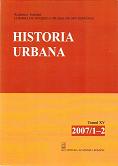Oraşul Sibiu şi băncile sale (secolul al XIX-lea – începutul secolului al XX-lea)
The Sibiu City and its Banks (19th Century – the Beginning of 20th Century)
Author(s): Mihai D. DrecinSubject(s): History
Published by: Editura Academiei Române
Keywords: Sibiu; credit institutions; Hermannstadter Allgemeine Sparkasse; Bodenkreditanstalt’s; Albina Bank; Transylvania Insurance Company; General Insurance Bank; Banks
Summary/Abstract: Set up by the Saxon colonists and circumscribed between the medieval walls, the Sibiu city would keep its “Saxon demographic purity” until the beginning of the modern epoch. Obliged by the feudal laws, the Romanians would settle down in the districts located outside the walls of the city, as after the legislation had been given by the Austrian emperors Maria Theresa and Joseph II they would start to conquer the Saxon town by work, intelligence and biological force. The exceptional Romanian ethnic reservoir of the Sibiu’s Bordering allows the rhythmical increasing of the Romanian community in the city situated by the Cibin River. After 1867 the Hungarian population has settled down especially as public office workers. Eclectically, from a demographical point of view, it was normally as the peoples to set up their own economical, cultural and religious institutions the activity of which was taking place in parallel, seldom crossing themselves. The credit institutions appear in this context, first of all being organized under the shape of the cooperatives, and then that of the anonymous joint-stock company banks. After the Hermannstadter Allgemeine Sparkasse (1841) and Bodenkreditanstalt’s (1872) banks have been set up the “Albina” (Bee) Bank was founded (1872) – being the first credit institution with clear Romanian capital. The merit of their consolidation and development is due to the two excellent organizers and innovators in the range: Karl Wolff and Partenie Cosma. An attempt of cooperation between the Saxons and Romanians by founding the “Transylvania” Insurance Company (1868-1908) fails because of the Saxon exclusivity. As a result, the Romanians set up the bases of the General Insurance Bank (1912). The Sibiu city becomes the Transylvanian Saxons and Romanians’ banking centre. The Romanians will publish “Revista Economică” (The Economical Review) (1899), set up the “Concordia” joint-stock company (1896-1904), initiate the reform of the personal banks in Transylvania by means of the of the Managers’ Conferences of the Romanian Banks (1898, 1901, 1903, 1906) which will lay the foundation of “Solidaritatea“ (The Solidarity) banking Union (1907). The bank officers, being in a continuous numerical increasing, are going to become a new socio-professional category imposing itself in the city world by considerable salaries and a high cultural refinement degree. The economical independence and the cultural degree will permit them to affirm themselves in the cultural, religious and fashionable life of Sibiu, some of them even in politics. The credit institutions become the true magnets for the clients in the area, peasants, tradesmen, intellectuals, assuring in this way the increasing the trade of goods as well as the change of people between village and town. The bank and the town are imposing themselves as a real tandem of the modernizing, Westerning and economical progress.
Journal: Historia Urbana
- Issue Year: XV/2007
- Issue No: 1+2
- Page Range: 23-34
- Page Count: 12
- Language: Romanian
- Content File-PDF

